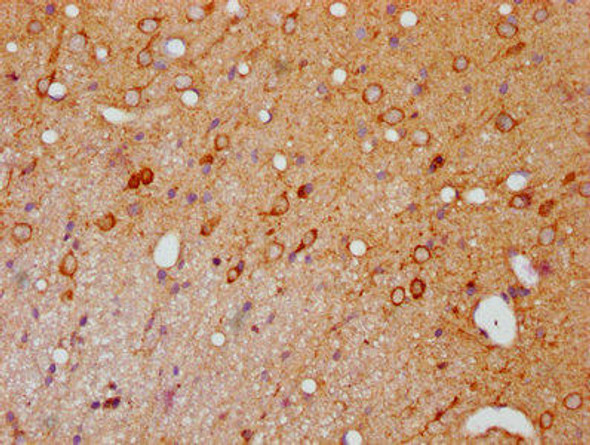Cell Death Antibodies 2
Anti-Phospho-PAK1-S199/S204 Antibody (CABP1125)
- SKU:
- CABP1125
- Product Type:
- Antibody
- Reactivity:
- Human
- Reactivity:
- Mouse
- Reactivity:
- Rat
- Host Species:
- Rabbit
- Isotype:
- IgG
- Antibody Type:
- Polyclonal Antibody
- Research Area:
- Cell Death
Description
| Antibody Name: | Anti-Phospho-PAK1-S199/S204 Antibody |
| Antibody SKU: | CABP1125 |
| Antibody Size: | 20uL, 50uL, 100uL |
| Application: | WB |
| Reactivity: | Human, Mouse, Rat |
| Host Species: | Rabbit |
| Immunogen: | A phospho specific peptide corresponding to residues surrounding S199/S204 of human PAK1. |
| Application: | WB |
| Recommended Dilution: | WB 1:500 - 1:2000 |
| Reactivity: | Human, Mouse, Rat |
| Positive Samples: |
| Immunogen: | A phospho specific peptide corresponding to residues surrounding S199/S204 of human PAK1. |
| Purification Method: | Affinity purification |
| Storage Buffer: | Store at -20°C. Avoid freeze / thaw cycles. Buffer: PBS with 0.02% sodium azide, 50% glycerol, pH7.3. |
| Isotype: | IgG |
| Sequence: | Email for sequence |
| Gene ID: | 5058 |
| Uniprot: | Q13153 |
| Cellular Location: | Cell junction, Cell membrane, Cell projection, Cytoplasm, focal adhesion, invadopodium, ruffle membrane |
| Calculated MW: | 60kDa/61kDa |
| Observed MW: | Refer to figures |
| Synonyms: | PAK1, PAKalpha, p21 (RAC1) activated kinase 1 |
| Background: | This gene encodes a family member of serine/threonine p21-activating kinases, known as PAK proteins. These proteins are critical effectors that link RhoGTPases to cytoskeleton reorganization and nuclear signaling, and they serve as targets for the small GTP binding proteins Cdc42 and Rac. This specific family member regulates cell motility and morphology. Alternatively spliced transcript variants encoding different isoforms have been found for this gene. [provided by RefSeq, Apr 2010] |
| UniProt Protein Function: | PAK1: a protein kinase of the STE20 family that regulates cell motility and morphology. Critical RhoGTPase effector that regulates cytoskeleton reorganization, the JNK MAPK pathway, and nuclear signaling. Binding of Rac/cdc42 to the PBD of PAK1 causes autophosphorylation and conformational change. Phosphorylated and activated by PDK. |
| UniProt Protein Details: | Protein type:Protein kinase, Ser/Thr (non-receptor); Kinase, protein; EC 2.7.11.1; Protein kinase, STE; STE group; STE20 family; PAKA subfamily Chromosomal Location of Human Ortholog: 11q13-q14 Cellular Component: axon; cytoplasm; cytosol; dendrite; filamentous actin; focal adhesion; Golgi apparatus; growth cone; intercellular junction; nuclear membrane; plasma membrane; protein complex; ruffle; Z disc Molecular Function:ATP binding; collagen binding; protein binding; protein kinase activity; protein kinase binding; protein serine/threonine kinase activity; Rac GTPase binding Biological Process: actin cytoskeleton reorganization; activation of protein kinase activity; amygdala development; apoptosis; axon guidance; branching morphogenesis of a tube; cell migration; cellular response to insulin stimulus; ephrin receptor signaling pathway; exocytosis; innate immune response; MAPKKK cascade; neurite morphogenesis; neuromuscular junction development; positive regulation of cell migration; positive regulation of estrogen receptor signaling pathway; positive regulation of JNK activity; positive regulation of peptidyl-serine phosphorylation; positive regulation of protein amino acid phosphorylation; positive regulation of stress fiber formation; protein amino acid autophosphorylation; protein amino acid phosphorylation; receptor clustering; regulation of apoptosis; regulation of gene expression; regulation of mitotic cell cycle; response to hypoxia; Rho protein signal transduction; small GTPase mediated signal transduction; stimulatory C-type lectin receptor signaling pathway; stress-activated protein kinase signaling pathway; T cell costimulation; T cell receptor signaling pathway; vascular endothelial growth factor receptor signaling pathway; wound healing |
| NCBI Summary: | This gene encodes a family member of serine/threonine p21-activating kinases, known as PAK proteins. These proteins are critical effectors that link RhoGTPases to cytoskeleton reorganization and nuclear signaling, and they serve as targets for the small GTP binding proteins Cdc42 and Rac. This specific family member regulates cell motility and morphology. Alternatively spliced transcript variants encoding different isoforms have been found for this gene. [provided by RefSeq, Apr 2010] |
| UniProt Code: | Q13153 |
| NCBI GenInfo Identifier: | 90111767 |
| NCBI Gene ID: | 5058 |
| NCBI Accession: | Q13153.2 |
| UniProt Secondary Accession: | Q13153,O75561, Q13567, Q32M53, Q32M54, Q86W79, |
| UniProt Related Accession: | Q13153 |
| Molecular Weight: | |
| NCBI Full Name: | Serine/threonine-protein kinase PAK 1 |
| NCBI Synonym Full Names: | p21 protein (Cdc42/Rac)-activated kinase 1 |
| NCBI Official Symbol: | PAK1 |
| NCBI Official Synonym Symbols: | PAKalpha |
| NCBI Protein Information: | serine/threonine-protein kinase PAK 1 |
| UniProt Protein Name: | Serine/threonine-protein kinase PAK 1 |
| UniProt Synonym Protein Names: | Alpha-PAK; p21-activated kinase 1; PAK-1; p65-PAK |
| Protein Family: | Serine/threonine-protein kinase |
| UniProt Gene Name: | PAK1 |
| UniProt Entry Name: | PAK1_HUMAN |






